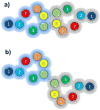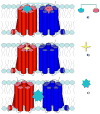Increasingly accurate dynamic molecular models of G-protein coupled receptor oligomers: Panacea or Pandora's box for novel drug discovery?
- PMID: 19465029
- PMCID: PMC2848910
- DOI: 10.1016/j.lfs.2009.05.004
Increasingly accurate dynamic molecular models of G-protein coupled receptor oligomers: Panacea or Pandora's box for novel drug discovery?
Abstract
For years, conventional drug design at G-protein coupled receptors (GPCRs) has mainly focused on the inhibition of a single receptor at a usually well-defined ligand-binding site. The recent discovery of more and more physiologically relevant GPCR dimers/oligomers suggests that selectively targeting these complexes or designing small molecules that inhibit receptor-receptor interactions might provide new opportunities for novel drug discovery. To uncover the fundamental mechanisms and dynamics governing GPCR dimerization/oligomerization, it is crucial to understand the dynamic process of receptor-receptor association, and to identify regions that are suitable for selective drug binding. This minireview highlights current progress in the development of increasingly accurate dynamic molecular models of GPCR oligomers based on structural, biochemical, and biophysical information that has recently appeared in the literature. In view of this new information, there has never been a more exciting time for computational research into GPCRs than at present. Information-driven modern molecular models of GPCR complexes are expected to efficiently guide the rational design of GPCR oligomer-specific drugs, possibly allowing researchers to reach for the high-hanging fruits in GPCR drug discovery, i.e. more potent and selective drugs for efficient therapeutic interventions.
Copyright 2009 Elsevier Inc. All rights reserved.
Figures



Similar articles
-
The structure and dynamics of GPCR oligomers: a new focus in models of cell-signaling mechanisms and drug design.Curr Opin Drug Discov Devel. 2005 Sep;8(5):577-84. Curr Opin Drug Discov Devel. 2005. PMID: 16159019 Review.
-
Structure-based molecular modeling approaches to GPCR oligomerization.Methods Cell Biol. 2013;117:91-104. doi: 10.1016/B978-0-12-408143-7.00005-0. Methods Cell Biol. 2013. PMID: 24143973
-
Structure and function of G protein-coupled receptor oligomers: implications for drug discovery.Wiley Interdiscip Rev Nanomed Nanobiotechnol. 2015 May-Jun;7(3):408-27. doi: 10.1002/wnan.1319. Epub 2014 Dec 17. Wiley Interdiscip Rev Nanomed Nanobiotechnol. 2015. PMID: 25521522 Review.
-
G-protein-coupled receptor heterodimerization: assay technologies to clinical significance.Curr Opin Drug Discov Devel. 2007 Sep;10(5):580-9. Curr Opin Drug Discov Devel. 2007. PMID: 17786857 Review.
-
Progress in elucidating the structural and dynamic character of G Protein-Coupled Receptor oligomers for use in drug discovery.Curr Pharm Des. 2009;15(35):4017-25. doi: 10.2174/138161209789824768. Curr Pharm Des. 2009. PMID: 20028319 Free PMC article. Review.
Cited by
-
Current Concepts and Treatments of Schizophrenia.Molecules. 2018 Aug 20;23(8):2087. doi: 10.3390/molecules23082087. Molecules. 2018. PMID: 30127324 Free PMC article. Review.
-
GPCRsort-responding to the next generation sequencing data challenge: prediction of G protein-coupled receptor classes using only structural region lengths.OMICS. 2014 Oct;18(10):636-44. doi: 10.1089/omi.2014.0073. Epub 2014 Aug 18. OMICS. 2014. PMID: 25133496 Free PMC article.
-
Communication over the network of binary switches regulates the activation of A2A adenosine receptor.PLoS Comput Biol. 2015 Feb 9;11(2):e1004044. doi: 10.1371/journal.pcbi.1004044. eCollection 2015 Feb. PLoS Comput Biol. 2015. PMID: 25664580 Free PMC article.
-
Heterodimerization of apelin receptor and neurotensin receptor 1 induces phosphorylation of ERK(1/2) and cell proliferation via Gαq-mediated mechanism.J Cell Mol Med. 2014 Oct;18(10):2071-81. doi: 10.1111/jcmm.12404. Epub 2014 Aug 28. J Cell Mol Med. 2014. PMID: 25164432 Free PMC article.
-
Application of in utero electroporation of G-protein coupled receptor (GPCR) genes, for subcellular localization of hardly identifiable GPCR in mouse cerebral cortex.Mol Cells. 2014 Jul;37(7):554-61. doi: 10.14348/molcells.2014.0159. Epub 2014 Jul 31. Mol Cells. 2014. PMID: 25078448 Free PMC article.
References
-
- AbdAlla S, Lother H, el Massiery A, Quitterer U. Increased AT(1) receptor heterodimers in preeclampsia mediate enhanced angiotensin II responsiveness. Nature Medicine. 2001;7(9):1003–1009. - PubMed
-
- Antony J, Kellershohn K, Mohr-Andra M, Kebig A, Prilla S, Muth M, Heller E, Disingrini T, Dallanoce C, Bertoni S, Schrobang J, Trankle C, Kostenis E, Christopoulos A, Holtje HD, Barocelli E, De Amici M, Holzgrabe U, Mohr K. Dualsteric GPCR targeting: a novel route to binding and signaling pathway selectivity. Faseb Journal. 2008 - PubMed
-
- Ballesteros JA, Weinstein H. Methods in Neurosciences. Academic Press; San Diego, CA: 1995. Integrated methods for the construction of three-dimensional models and computational probing of structure-function relations in G protein-coupled receptors; pp. 366–428.
-
- Berque-Bestel I, Lezoualc'h F, Jockers R. Bivalent ligands as specific pharmacological tools for g protein-coupled receptor dimers. Current Drug Discovery Technology. 2008;5(4):312–318. - PubMed
Publication types
MeSH terms
Substances
Grants and funding
LinkOut - more resources
Full Text Sources

